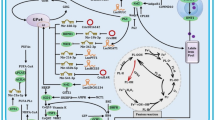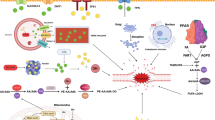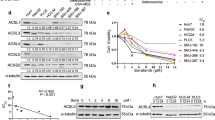Abstract
Purpose
Hepatocellular carcinoma (HCC) is a complicated disease with low survival rate due to frequent recurrence and the lack of efficient therapies. For advanced HCC, sorafenib, as the only approved first-line drug for HCC, improves the survival to some extent, but depressingly with severe adverse effects and emerging resistance conditions, which cause a poor prognosis. Ferroptosis is a new recognized way of non-apoptosis-regulated cell death, characterized by the iron-dependent accumulation of lipid hydroperoxides, showing a tremendous promising in the therapy of cancer, especially in HCC. To provide ideas for the diagnosis and treatment of HCC, we summarized the role of ferroptosis in HCC.
Methods
The relevant literature from PubMed is reviewed in this article.
Results
Interestingly enough, investigators have found sorafenib can induce ferroptosis in HCC. Moreover, recent researches reported increasing pathways and mechanisms related to ferroptosis in HCC such as TP53 and Rb, and strategies to improve sorafenib resistance by targeting ferroptosis. In addition, other drugs were reported to induce ferroptosis in HCC such as erastin and showed good efficacy in vivo and in vitro.
Conclusion
In this review, we summarize pathways and mechanisms of ferroptosis in HCC and other digestive system neoplasms such as gastric cancer, pancreatic cancer and colorectal cancer and point out the trends of ferroptosis in HCC.


Similar content being viewed by others
Abbreviations
- HCC:
-
Hepatocellular carcinoma
- RCD:
-
Regulated cell death
- NRF2:
-
Nuclear factor erythroid 2-related factor 2
- RPL8:
-
Ribosomal protein L8
- IREB2:
-
Iron-responsive element-binding protein 2
- ATP5G3:
-
ATP synthase F0 complex subunit C3
- CS:
-
Citrate synthase
- TTC35:
-
Tetratricopeptide repeat domain 35
- ACSF2:
-
Acyl-CoA synthetase family member 2
- GSH:
-
Glutathione
- ROS:
-
Reactive oxygen species
- GPX4:
-
Glutathione peroxidase 4
- DLBCL:
-
Diffuse large B-cell lymphoma
- RCC:
-
Renal cell carcinoma
- PC:
-
Pancreatic cancer
- SSZ:
-
Sulfasalazine
- DFX:
-
Deferoxamine
- Rb:
-
Retinoblastoma
- Keap1:
-
Kelch-like ECH-associated protein 1
- Maf:
-
V-maf avian musculoaponeurotic fibrosarcoma oncogene homolog
- NQO1:
-
Quinone oxidoreductase 1
- HO1:
-
Heme oxygenase-1
- FTH1:
-
Ferritin heavy chain 1
- MT:
-
Metallothionein
- HIF1α:
-
Hypoxia-inducible factor 1-alpha
- S1R:
-
Sigma 1 receptor
- CISD1:
-
CDGSH iron sulfur domain 1
- S47:
-
Ser 47
- ACSL4:
-
Acyl-CoA synthetase long-chain family member 4
- 5-HETE:
-
5-Hydroxyeicosatetraenoic acid
- LDL–DHA:
-
Low-density lipoprotein docosahexaenoic acid
- GC:
-
Gastric cancer
- CRC:
-
Colorectal cancer
- CDO1:
-
Cysteine dioxygenase 1
- PDAC:
-
Pancreatic ductal adenocarcinoma
- CN-A:
-
Cotylenin A
- PEITC:
-
Phenethyl isothiocyanate
- PL:
-
Piperlongumine
- HSPA5:
-
Heatshock 70-kDa protein 5
- LOX:
-
Lipoxygenases
- ALOX:
-
Arachidonate lipoxygenase
- NCOA4:
-
Nuclear receptor coactivator 4
- CHOP:
-
C/EBP-homologous protein
- TRAIL:
-
Tumor necrosis factor-related apoptosis-inducing ligand
- DPP4:
-
Dipeptidyl-peptidase-4
References
Alvarez SW et al (2017) NFS1 undergoes positive selection in lung tumours and protects cells from ferroptosis. Nature 551:639–643. https://doi.org/10.1038/nature24637
Arlt A et al (2013) Inhibition of the Nrf2 transcription factor by the alkaloid trigonelline renders pancreatic cancer cells more susceptible to apoptosis through decreased proteasomal gene expression and proteasome activity. Oncogene 32:4825–4835. https://doi.org/10.1038/onc.2012.493
Bai T, Wang S, Zhao Y, Zhu R, Wang W, Sun Y (2017) Haloperidol, a sigma receptor 1 antagonist, promotes ferroptosis in hepatocellular carcinoma cells. Biochem Biophys Res Commun 491:919–925. https://doi.org/10.1016/j.bbrc.2017.07.136
Bruix J et al (2017) Regorafenib for patients with hepatocellular carcinoma who progressed on sorafenib treatment (RESORCE): a randomised, double-blind, placebo-controlled, phase 3 trial. Lancet (London England) 389:56–66. https://doi.org/10.1016/s0140-6736(16)32453-9
Chen WC, Wang CY, Hung YH, Weng TY, Yen MC, Lai MD (2016) Systematic analysis of gene expression alterations and clinical outcomes for long-chain acyl-coenzyme a synthetase family in cancer. PloS One 11:e0155660. https://doi.org/10.1371/journal.pone.0155660
Cheng AL et al (2009) Efficacy and safety of sorafenib in patients in the Asia-Pacific region with advanced hepatocellular carcinoma: a phase III randomised, double-blind, placebo-controlled trial. Lancet Oncol 10:25–34. https://doi.org/10.1016/s1470-2045(08)70285-7
Dixon SJ et al (2012) Ferroptosis: an iron-dependent form of nonapoptotic cell death. Cell 149:1060–1072. https://doi.org/10.1016/j.cell.2012.03.042
Dixon SJ et al (2014) Pharmacological inhibition of cystine-glutamate exchange induces endoplasmic reticulum stress ferroptosis. Elife 3:e02523. https://doi.org/10.7554/eLife.02523
Do Van B et al (2016) Ferroptosis, a newly characterized form of cell death in Parkinson’s disease that is regulated by PKC. Neurobiol Dis 94:169–178. https://doi.org/10.1016/j.nbd.2016.05.011
Eling N, Reuter L, Hazin J, Hamacher-Brady A, Brady NR (2015) Identification of artesunate as a specific activator of ferroptosis in pancreatic cancer cells. Oncoscience 2:517–532. https://doi.org/10.18632/oncoscience.160
Firestone RA (1994) Low-density lipoprotein as a vehicle for targeting antitumor compounds to cancer cells. Bioconj Chem 5:105–113
Friedmann Angeli JP et al (2014) Inactivation of the ferroptosis regulator Gpx4 triggers acute renal failure in mice. Nat Cell Biol 16:1180–1191. https://doi.org/10.1038/ncb3064
Galmiche A, Chauffert B, Barbare JC (2014) New biological perspectives for the improvement of the efficacy of sorafenib in hepatocellular carcinoma. Cancer Lett 346:159–162. https://doi.org/10.1016/j.canlet.2013.12.028
Guo J et al (2018) Ferroptosis: a novel anti-tumor action for cisplatin. Cancer Res Treat 50:445–460. https://doi.org/10.4143/crt.2016.572
Hambright WS, Fonseca RS, Chen L, Na R, Ran Q (2017) Ablation of ferroptosis regulator glutathione peroxidase 4 in forebrain neurons promotes cognitive impairment and neurodegeneration. Redox Biol 12:8–17 https://doi.org/10.1016/j.redox.2017.01.021
Hao S et al (2017) Cysteine dioxygenase 1 mediates erastin-induced ferroptosis in human gastric cancer cells. Neoplasia (New York NY) 19:1022–1032. https://doi.org/10.1016/j.neo.2017.10.005
Harrison PM, Arosio P (1996) The ferritins: molecular properties, iron storage function and cellular regulation. Biochim Biophys Acta 1275:161–203
Hayano M, Yang WS, Corn CK, Pagano NC, Stockwell BR (2016) Loss of cysteinyl-tRNA synthetase (CARS) induces the transsulfuration pathway and inhibits ferroptosis induced by cystine deprivation. Cell Death Diff 23:270–278. https://doi.org/10.1038/cdd.2015.93
Hayes JD, McLellan LI (1999) Glutathione and glutathione-dependent enzymes represent a co-ordinately regulated defence against oxidative stress. Free Rad Res 31:273–300
Hong SH et al (2017) Molecular crosstalk between ferroptosis and apoptosis: emerging role of ER stress-induced p53-independent. PUMA Exp Oncotarget 8:115164–115178. https://doi.org/10.18632/oncotarget.23046
Hou W et al (2016) Autophagy promotes ferroptosis by degradation of ferritin. Autophagy 12:1425–1428. https://doi.org/10.1080/15548627.2016.1187366
Hsu C, Shen YC, Cheng AL (2009) Sorafenib for the treatment of hepatocellular carcinoma across geographic regions. Expert Rev Clin Pharmacol 2:129–136. https://doi.org/10.1586/17512433.2.2.129
Jennis M et al (2016) An African-specific polymorphism in the TP53 gene impairs p53 tumor suppressor function in a mouse model. Genes Dev 30:918–930 https://doi.org/10.1101/gad.275891.115
Kasukabe T, Honma Y, Okabe-Kado J, Higuchi Y, Kato N, Kumakura S (2016) Combined treatment with cotylenin A and phenethyl isothiocyanate induces strong antitumor activity mainly through the induction of ferroptotic cell death in human pancreatic cancer cells. Oncol Rep 36:968–976. https://doi.org/10.3892/or.2016.4867
Khan MR, Xiang S (2017) The p53-inducible long noncoding RNA TRINGS protects cancer cells from necrosis under glucose starvation. EMBO J 36:3483–3500. https://doi.org/10.15252/embj.201696239
Kinowaki Y et al (2018) Glutathione peroxidase 4 overexpression inhibits ROS-induced cell death in diffuse large B-cell lymphoma Laboratory investigation. J Tech Methods Pathol. https://doi.org/10.1038/s41374-017-0008-1
Knudsen ES, Knudsen KE (2008) Tailoring to RB: tumour suppressor status and therapeutic response. Nat Rev Cancer 8:714–724. https://doi.org/10.1038/nrc2401
Lachaier E et al (2014) Sorafenib induces ferroptosis in human cancer cell lines originating from different solid tumors. Anticancer Res 34:6417–6422
Liu L et al (2006) Sorafenib blocks the RAF/MEK/ERK pathway, inhibits tumor angiogenesis, and induces tumor cell apoptosis in hepatocellular carcinoma model PLC/PRF/5. Cancer Res 66:11851–11858. https://doi.org/10.1158/0008-5472.can-06-1377
Liu J, Liu Y, Meng L, Liu K, Ji B (2017) Targeting the PD-L1/DNMT1 axis in acquired resistance to sorafenib in human hepatocellular carcinoma. Oncol Rep 38:899–907. https://doi.org/10.3892/or.2017.5722
Llovet JM et al (2008) Sorafenib in advanced hepatocellular carcinoma. N Engl J Med 359:378–390. https://doi.org/10.1056/NEJMoa0708857
Louandre C, Ezzoukhry Z, Godin C, Barbare JC, Maziere JC, Chauffert B, Galmiche A (2013) Iron-dependent cell death of hepatocellular carcinoma cells exposed to sorafenib. Int J Cancer 133:1732–1742. https://doi.org/10.1002/ijc.28159
Louandre C et al (2015) The retinoblastoma (Rb) protein regulates ferroptosis induced by sorafenib in human hepatocellular carcinoma cells. Cancer Lett 356:971–977. https://doi.org/10.1016/j.canlet.2014.11.014
Ma Q (2013) Role of nrf2 in oxidative stress and toxicity. Annu Rev Pharmacol Toxicol 53:401–426. https://doi.org/10.1146/annurev-pharmtox-011112-140320
Ma S, Henson ES, Chen Y, Gibson SB (2016) Ferroptosis is induced following siramesine and lapatinib treatment of breast cancer cells. Cell Death Dis 7:e2307. https://doi.org/10.1038/cddis.2016.208
Mayhew CN et al (2007) RB loss abrogates cell cycle control and genome integrity to promote liver tumorigenesis. Gastroenterology 133:976–984. https://doi.org/10.1053/j.gastro.2007.06.025
Mrakovcic M, Frohlich LF (2018) p53-mediated molecular control of autophagy in tumor cells. Biomolecules. https://doi.org/10.3390/biom8020014
Ou W, Mulik RS, Anwar A, McDonald JG, He X, Corbin IR (2017) Low-density lipoprotein docosahexaenoic acid nanoparticles induce ferroptotic cell death in hepatocellular carcinoma. Free Rad Biol Med 112:597–607. https://doi.org/10.1016/j.freeradbiomed.2017.09.002
Shi X et al (2014) Nutlin-3 downregulates p53 phosphorylation on serine392 and induces apoptosis in hepatocellular carcinoma cells. BMB Rep 47:221–226
Shintoku R et al (2017) Lipoxygenase-mediated generation of lipid peroxides enhances ferroptosis induced by erastin and RSL3. Cancer Sci 108:2187–2194 https://doi.org/10.1111/cas.13380
Sun X, Niu X, Chen R, He W, Chen D, Kang R, Tang D (2016a) Metallothionein-1G facilitates sorafenib resistance through inhibition of ferroptosis. Hepatology (Baltimore, Md) 64:488–500. https://doi.org/10.1002/hep.28574
Sun X, Ou Z, Chen R, Niu X, Chen D, Kang R, Tang D (2016b) Activation of the p62-Keap1-NRF2 pathway protects against ferroptosis in hepatocellular carcinoma cells. Hepatology (Baltimore, Md) 63:173–184. https://doi.org/10.1002/hep.28251
Suzuki T, Motohashi H, Yamamoto M (2013) Toward clinical application of the Keap1-Nrf2 pathway. Trends Pharmacol Sci 34:340–346. https://doi.org/10.1016/j.tips.2013.04.005
Taira N, Nihira K, Yamaguchi T, Miki Y, Yoshida K (2007) DYRK2 is targeted to the nucleus and controls p53 via Ser46 phosphorylation in the apoptotic response to. DNA Damage Mol Cell 25:725–738. https://doi.org/10.1016/j.molcel.2007.02.007
Tonnus W, Linkermann A (2016) “Death is my Heir"—ferroptosis connects cancer pharmacogenomics and ischemia-reperfusion injury. Cell Chem Biol 23:202–203. https://doi.org/10.1016/j.chembiol.2016.02.005
Torre LA, Bray F, Siegel RL, Ferlay J, Lortet-Tieulent J, Jemal A (2015) Global cancer statistics, 2012. CA Cancer J Clin 65:87–108. https://doi.org/10.3322/caac.21262
Wang XJ et al (2008) Nrf2 enhances resistance of cancer cells to chemotherapeutic drugs the dark side of Nrf2. Carcinogenesis 29:1235–1243. https://doi.org/10.1093/carcin/bgn095
Wang D, Peng Y, Xie Y, Zhou B, Sun X, Kang R, Tang D (2016) Antiferroptotic activity of non-oxidative dopamine. Biochem Biophys Res Commun 480:602–607. https://doi.org/10.1016/j.bbrc.2016.10.099
Woo SM et al (2018) Corosolic acid induces non-apoptotic cell death through generation of lipid reactive oxygen species production in human renal carcinoma caki. Cells 19 https://doi.org/10.3390/ijms19051309
Xie Y et al (2016) Identification of baicalein as a ferroptosis inhibitor by natural product library screening. Biochem Biophys Res Commun 473:775–780. https://doi.org/10.1016/j.bbrc.2016.03.052
Xie Y et al (2017) The Tumor Suppressor p53 Limits Ferroptosis by Blocking DPP4. Activity Cell Rep 20:1692–1704. https://doi.org/10.1016/j.celrep.2017.07.055
Yamaguchi Y, Kasukabe T, Kumakura S (2018) Piperlongumine rapidly induces the death of human pancreatic cancer cells mainly through the induction of ferroptosis. Int J Oncol 52:1011–1022. https://doi.org/10.3892/ijo.2018.4259
Yang WS et al (2014) Regulation of ferroptotic cancer cell death by GPX. 4 Cell 156:317–331. https://doi.org/10.1016/j.cell.2013.12.010
Yuan H, Li X, Zhang X, Kang R, Tang D (2016) CISD1 inhibits ferroptosis by protection against mitochondrial lipid peroxidation. Biochem Biophys Res Commun 478:838–844. https://doi.org/10.1016/j.bbrc.2016.08.034
Zhu S, Zhang Q, Sun X, Zeh HJ 3rd, Lotze MT, Kang R, Tang D (2017) HSPA5 regulates ferroptotic cell death in cancer cells. Cancer Res 77:2064–2077. https://doi.org/10.1158/0008-5472.can-16-1979
Acknowledgements
We are grateful to the staff at the GI oncology of cancer hospital of HMU. And we thank Kainan Kang for his critical reading of the manuscript.
Funding
This study was funded by the National Natural Scientific Foundation of China (No. 81302060, No.81472322 and No. 81672930), the national youth talent support program for TS Zheng, the Natural Science Foundation of Heilongjiang Province (LC201437/H1617), China Postdoctoral Science Foundation (No. 2015T80369 and No. 2014M560271), and Heilongjiang Postdoctoral Science Foundation (No. LBH-Z14142 and No. LBH-TZ1615), the Fok Ying Tung Education Foundation (No. 151037), the Academician Yu Weihan Outstanding youth foundation of Harbin Medical University for TS Zheng. The funders had no role in study design, data collection and analysis, decision to publish, or preparation of the manuscript.
Author information
Authors and Affiliations
Corresponding author
Ethics declarations
Conflict of interest
Authors declare no conflict of interests.
Ethical approval
This article does not contain any studies with human participants or animals performed by any of the authors.
Rights and permissions
About this article
Cite this article
Nie, J., Lin, B., Zhou, M. et al. Role of ferroptosis in hepatocellular carcinoma. J Cancer Res Clin Oncol 144, 2329–2337 (2018). https://doi.org/10.1007/s00432-018-2740-3
Received:
Accepted:
Published:
Issue Date:
DOI: https://doi.org/10.1007/s00432-018-2740-3




